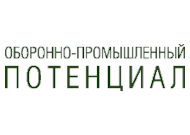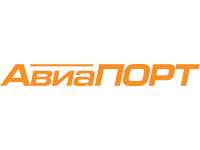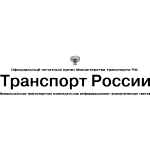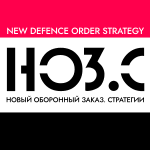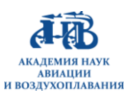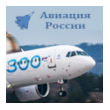HeliRussia 2017: Impressive Results from the Anniversary Expo
HeliRussia, the International helicopter industry exhibition, has been making history since 2008 and has demonstrated the entire spectrum of production and services of the helicopter industry. HeliRussia is held in accordance with Russian Government order; the organizer of the expo is the Russian Ministry of Industry and Trade. The main sponsor of the event is Russian Helicopters; the official partner is Exclases Holdings. The expo is held under the initiative and with the support of the Helicopter Industry Association (HIA).
Today HeliRussia is rightfully considered to be the primary Russian sectoral event and the largest helicopter expo in Europe and Northern Asia. The 10th Anniversary expo took place from 25 to 27 May in Moscow this year and will be well remembered by participants and guests thanks to its grand scale and the abundance of news and events. The expo was attended by more than 12,000 people.
The anniversary HeliRussia 2017 set an all-time record over its entire history in terms of scale and scope. The expo was attended by 237 companies, both recognized giants and leaders in helicopter industry and small beginning start-ups. Having exhibits from companies of different levels on the same grounds allowed the visitors and industry specialists get the most complete picture of the current state of affairs in the helicopter industry.
The core of the Russian exposition was made up of major Russian field-related holding companies under Rostec banner: Russian Helicopters, Rosoboronexport, Tehnodinamika, KRET, United Engine Corporation, and Shvabe. The exposition was also attended by influential industry-specific private companies, such as UTair, Russian House of Aviation, Spark, Beta IR, Prima Research & Production Enterprise, Aviakom Research & Production Enterprise, PANH Helicopters, “Nauka” Science Scientific Industrial Enterprise, Tulpar Aero Group, Gaznanoteh and many others.
50 foreign companies were present with 21 countries participated in HeliRussia 2017, namely, Australia, Belarus, Belgium, China, Czech Republic, Estonia, Finland, France, Germany, Great Britain, Israel, Italy, Libya, Lithuania, Malta, Netherlands, Norway, Russia, South Africa, Spain and USA.
The number of foreign participants this year coincides with those for HeliRussia 2012—both then and now 50 companies took part in the expo, which is the largest number of foreign participants in the history of the event. However, in terms of the number of participating countries (21), HeliRussia 2017 set a record—the previous largest number of participants (20) was set in 2014. Taking into account the current political situation, which led to a drop in the number of foreign participants in previous years, as well as the worldwide decline in the helicopter industry, which was influenced by the economic drop in the oil and gas sector, the current indicators of foreign involvement in the HeliRussia can be called truly phenomenal. This clearly demonstrates the importance of international cooperation in the aerospace and the role of the helicopter industry in intergovernmental relations.
Nearly all of the leading foreign manufacturers of helicopter equipment or their representatives took part in HeliRussia 2017. Besides, lots of producers of ancillary equipment and services also participated in the expo. Noteworthy is the participation of a number of French companies, including Esterline, Hutchinson, Nicomatic, Permaswage, and Sela, at a separate national booth under the aegis of Business France agency, which is the representative for trade and investment of the Embassy of France in Russia.
23 helicopters and 2 autogiros, as well as 16 drones manufactured domestically and abroad were presented at the expo.
Helicopters on display
A substantial part of the expo of rotorcrafts consisted of Russian Helicopters, such as the new transport Mi‑38T, the Mi‑171A2, and the Ansat helicopter in three production versions: medevac, passenger and the Ansat‑RT with a new set of avionics presented by the Ramenskiy Instrument Design Bureau. One more Ansat did a demonstration flight for potential purchasers.
Among other interesting Russian-made models that were presented at HeliRussia 2017, great attention was drawn to a flight model of the superlight helicopter Afalina by the HeliWhale and the ultralight Mikron by RD‑Heli.
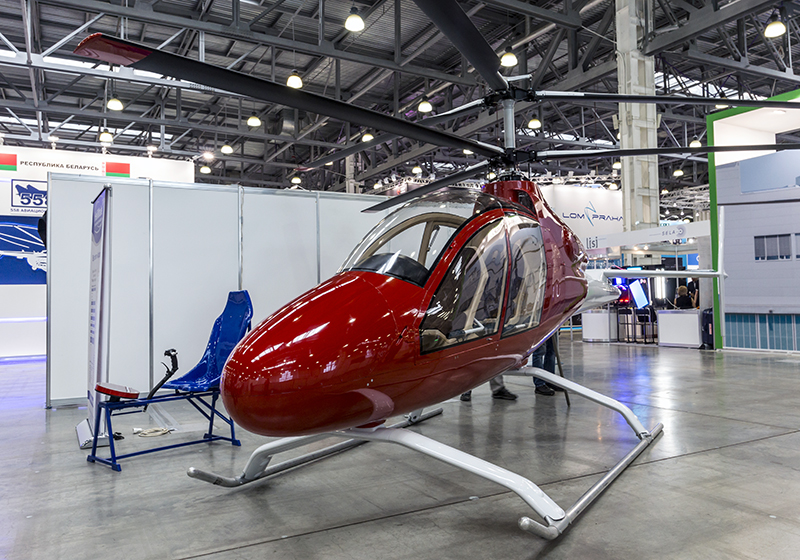
Afalina is a light two-seat helicopter of coaxial design that was first presented at HeliRussia 2015. This year’s exposition presented a flight model that has already undergone a number of tests and will soon enter flight trials. The developers plan the helicopter to be used for a wide range of tasks, such as flight training, monitoring and patrolling, passenger transport, agricultural operations, helicopter sports, and much more.
Mikron is a minimalist “air scooter”. The apparatus has outstanding maneuvering and speed characteristics, can remain airborne for two hours, can climb to a height of 3000 meters, and can accelerate to 120 km/h. The diameter of the lift rotors, built on coaxial design, is about 4.5 meters, which is sufficient to lift one person into the air. Moreover, the two-seater and an amphibious version of Mikron are in development.
The official partner of HeliRussia 2017, Exclases Holdings, the certified dealer of Leonardo Helicopters in Russia and the CIS, presented three helicopters: light AW109 and AW119, as well as the midweight multipurpose AW139, assembled in Russia.
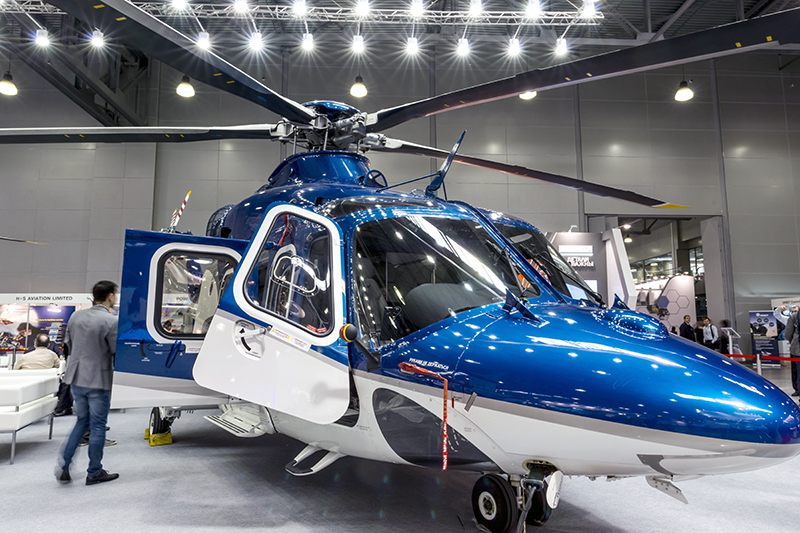
The AW139 helicopters are manufactured in Russia at HeliVert plant, which is a joint enterprise of Russian Helicopters and Italian Leonardo Helicopters. The first helicopter assembled at this plant made its first flight at the end of 2012.

Bell Helicopter (a part of Textron) presented the Bell 407GXP, assembled at the Urals Civil Aviation Plant (UCAP). The presented model is one of the first machines assembled under the licensing agreement between Bell Helicopter and the UCAP, purposed to localize the production of helicopters of this type.
Airbus Helicopters showcased the Moscow Aviation Center’s H145 medevac helicopter. This model was used by the personnel from the scientific-practical center for emergency medical assistance of Moscow’s Department of Health and from the Moscow Aviation Center to hold a master class on the operation of the air medical team. This event was held as part of the 5th Intergovernmental HEMS Conference, which took place during HeliRussia 2017. The medevac H145 can be used for rendering emergency medical assistance and for transporting patients while conducting intensive therapy.
Other helicopters manufactured by the European company included the models AS350 B2, the AS355, and the H125, which were presented at the booths of other companies and dealers.
As always, Robinson R44 and R66 helicopters, popular in Russia and throughout the world, were widely exhibited. These helicopters were shown by the companies Aviamarket (Heliport Istra), Heliatica, and Trend‑Line.
A unique Canadian helicopter Safari was also on display. It was presented at the expo by the Aviamaster company. Safari is a kit-assembled helicopter. It is known for its simple open design, ample life cycle, and efficient Lycoming powerplant.
Drones on display
Worldwide developments in UAV technologies, which has considerable overlap with the helicopter industry, find their reflection every year at HeliRussia. This year’s expo showed mass-produced and experimental models, as well as technology demonstrators.
The most notable Russian development turned out to be the prototype of a heavy-lift cargo drone with working title Unpiloted Automatic System for Design Under Study Adjustment (Russian: BAS YURIK). It is a multipurpose multi-copter system, distinguished by its unusual aerodynamic makeup and flight algorithm. BAS YURIK is a co-branded project of Elektroavtomatika and Aerospace Technologies, Ltd.
The UAV technologies drew attention of the top industry companies. Thus, at HeliRussia 2017 the VR‑Technologies design bureau (part of Russian Helicopters) showed an experimental model of the modernized tiltrotor RHV‑30, which is currently undergoing flight testing. Mass production is planned for 2018-2019.
The Voron drone, developed by the Moscow Aviation Institute, was also displayed. This model possesses a wide range of applications and is constantly being updated; it is already in the service of Russian law enforcement agencies.
Among the drones of foreign manufacture presented at HeliRussia 2017, Russian premiere of Chinese drones by Sunic took place. Four models were presented: H2M, designed for marine use, SU‑FA200 with hybrid design, SU‑M6 hexacopter powered by lithium-polymer batteries, and SU‑MX01, a tethered test drone.
In addition, several other foreign drone models were on display, for example, Penguin-C from UAV Factory (Latvia) and Lehmann Aviation’s LA 500 (France).
Other aircrafts on display
Besides the BAS YURIK, its developers showcased a new aircraft on Begalet platform called ECOX7 “Greenfly”. It is an environmentally friendly electric wheeled aircraft, designed for use in nature preserve areas. The developer of the apparatus promised to present a two-seat version of this interesting machine in the near future.
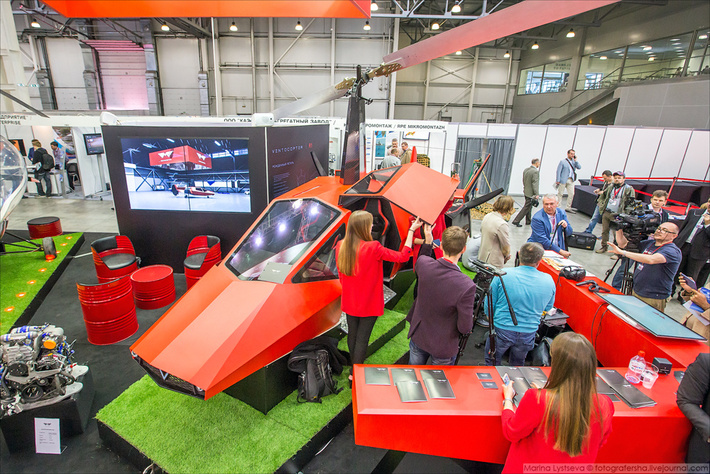
Among the Russian-made novelties was a demonstration of gyroplanes from Ventocopter; the models A1 and R1 “Shark”. The gyroplane, or autogiro, is in essence a light helicopter, supported in flight by the bearing surface of a bearing rotor freely rotating in autorotation mode. It gets its horizontal speed thanks to a pushing rotor located in the tail. Such an aircraft can land under practically any conditions, even if it has run out of fuel.
The three-seat R1 “Shark” is equipped with a 250-hp rotor engine fueled by regular grade 92 gasoline. This model is geared toward use in general aviation. The first flying model is planned to be brought out this summer. The A1 is a heavy-lift multipurpose gyroplane with an internal combustion gasoline engine (it uses grade 95 gasoline), presently being prepared for mass production.
Helicopter programs news
HeliRussia 2017 has brought a multitude of innovations in the field of helicopter programs—the expo enjoys a reputation of the main industry-related event of the year, where Russian and international companies tell about their plans, achievements, and future projects.
One of the most important events at HeliRussia 2017 was the successful first flight of the new Ka‑62 Russian helicopter, which it performed on 25 May at the base of the Progress Arsenyev Aviation Company, part of the Russian Helicopters based in the city of Arsenyev, Far East. Although the helicopter itself was not shown at the expo, representatives of the compant set up a live connection with the plant and took part in a large-scale press conference about the Ka‑62 helicopter, which was held on 26 May.
The Russian Deputy Minister for Industry and Trade, Oleg Bocharov, along with Andrey Boginskiy, CEO of Russian Helicopters, Vladimir Makareykin, Executive Director of Kamov, Yuriy Denisenko, Managing Director of the Progress Arsenyev Aviation Company, Sergey Mikheyev, General Designer of Kamov and President of the HIA, Aleksandr Vagin, Chief Designer of the Ka‑62, and Mikhail Kazachkov, Chairman of the Board of the HIA, participated in the press conference. At the press conference the participants spoke about the course of the Ka‑62 helicopter program and its prospects, which on the whole are assessed as positive. Certification of the helicopter is expected in 2019, with the first delivery in 2020.
At HeliRussia 2017, representatives of Russian Helicopters spoke about other projects. Development of the Mi‑26 helicopter evoked great interest— the production of the modernized Mi‑26T2 is presently underway, and the company is also working on updating the military transport Mi‑26T2V for the Russian Ministry of Defense. The defense department also ordered a new batch of Ka‑226T helicopters in shipborne configuration that will be delivered this year, and the purchases of the military transport version of the Mi‑38 helicopter are included in the government armaments program through 2025.
Earlier, at HeliRussia 2016, it was announced that the Russian Ministry of Defense would be the first purchaser of the new multipurpose Mi‑38 helicopter, produced by the Kazan Helicopter Plant of Russian Helicopters. The transport version of the Mi‑38 helicopter has increased functionality and expanded area of application, through specialized versions, including the “Arctic” variant.
Another important innovation from Russian Helicopters is the new Mi‑171A2 medium multipurpose helicopter: certification for this aircraft is planned on 15 August 2017; major helicopter operators are already expressing interest in this model. A prototype of the Mi‑171A2 greeted visitors on a static platform in front of the entrance to the exposition alongside the Mi‑38T helicopter—both machines drew plenty of attention from exposition guests.
In addition, according to an announcement from Andrey Boginskiy, CEO of Russian Helicopters, the company is conducting research and development of an unmanned version of the Ka‑226T.
Regarding foreign models, representatives from Bell Helicopter and Jet Transfer (its local dealer) spoke about Bell 407GXP production in Russia. As of now, Bell Helicopter has delivered four assembly sets for the helicopter to the UWCA, and during this year the plant will receive at least one more such set. By 2020 UWCA plans to deliver 20 Russian-assembled Bell 407GXP helicopters to purchasers.
Certainly, the newest and most awaited in its class helicopter, the Bell 505 Jet Ranger X, was mentioned. In particular, it was noted that the possibility of localized production of this helicopter at UWCA exists.
During HeliRussia 2017, the Airbus Helicopters announced that a new pricing policy is being introduced in Russia for delivery of spare parts and components for the European manufacturer’s helicopters. The company expects the new simple and transparent system for pricing to help clients predict expenditures for spare parts.
Industry companies on show
Nearly all leading Russian companies — manufacturers of aviation equipment, providers of services & components, and industry holdings — take part in HeliRussia every year.
Rosoboronexport presented a line-up of Russian-made military helicopters intended for export. It was announced that the portfolio of the company’s offerings this year has been updated with the modernized version of the Mi‑35P helicopter, which substantially exceeds the basic model in terms of onboard equipment.

The Radioelectronic Technologies Concern (KRET) demonstrated more than 80 exhibits of modern helicopter radioelectronic equipment at HeliRussia 2017. In particular, a helmet-mounted system for targeting and indication and N‑025E onboard radar station, components of Mi‑28N(E) Night Hunter attack helicopter equipment. KRET also showed the LCN‑296 laser guidance system, which is installed on Ka‑52 Alligator and Mi‑8MNP helicopters and used to guide missiles of various sorts. In addition, visitors could acquaint themselves with the laser station that is part of the “President‑S” optical-electronic infrared countermeasures system for airplanes and helicopters.
The Ramenskiy Instrument Design Bureau (RPKB), a subsidiary of KRET, introduced the latest set of avionics on a test Ansat‑RT helicopter at a separate display. This set includes displays, computers, radio, navigation, and much more. The set was designed as universal for helicopters with various purposes, cabin sizes, and tasks. The new set for the Ansat helicopter is expected to receive its certification this year.
The RPKB was notably active in cooperating with other companies. It was announced at HeliRussia 2017 that RPKB will deliver GLONASS navigation receivers for Airbus Helicopters H125 (AS350 B3) and H130 (EC130 T2). Its installation is required by Russian air laws. Jointly with Heliatica, RPKB showed a prototype monitoring system for landing assistance — “helicopter parktronic”—certification for which is planned to be completed in Europe, US, and Russia by the summer-end of 2017.
Tehnodinamika, a leading domestic developer of aviation equipment, showed its latest achievements. For example, the company is working on a new generation of helicopter engines.
The United Engine Corporation (UEC) presented at HeliRussia 2017 Klimov TV7‑117V helicopter engine along with BARK‑6V full authority digital engine control system (FADEC) for this engine type.
Shvabe presented a line of optical systems for commercial, military and dual application. Specifically, products from its Urals Optical & Mechanical Plant and Krasnogorsky Zavod were presented at the expo — the SON 730, SON 820, and SMS 831 systems for optical observation, as well as a reconnaissance and targeting station with gyro stabilization for the Mi‑28N(M) Night Hunter attack helicopter.
The Russian House of Aviation shared information about its activities regarding aircraft operation support and demonstrated products from its partner, Scientific-Technical Company ASD —an automated diagnostics system for electronic units of Russian aircraft.
The French company Safran Helicopter Engines (formerly Turbomeca) presented its line-up of helicopter engines. This manufacturer’s power plants are installed in numerous helicopters, including the Russian Ka‑226T and Ka‑62.
At the VKMS Company’s booth at HeliRussia 2017 one could see the TV3‑117VMA‑SBMV turboshaft engine, as well as the Ai‑9V‑1 auxiliary powerplant. These models are developed for installation on Mi‑8/17 type helicopters.
Among the foreign engines the Rolls-Royce M250 and RR300 were presented by an official supplier—the Aeromaritime Mediterranean from the Republic of Malta.
The H+S Aviation from the UK acquainted visitors of HeliRussia 2017 with its program of certified technical support for the Rolls-Royce M250 aircraft engines and other models produced abroad. This company possesses all the resources for rendering ongoing repairs and major overhaul of engines and has been operating in the Russian market since 2001 with all the required certification.
PBS Velka Bites, a developer and manufacturer of aviation engines from the Czech Republic, presented primary and auxiliary power plants for helicopters at HeliRussia 2017. Specifically, the TS100 turboshaft engine for ultralight helicopters and UAVs, with 180 kW of power.
Besides the companies that hold a solid position in the market, HeliRussia annually showcases new and start-up companies. This year among aviation engines, the Russian company Engines for Aviation became such a debutant, for the first time showing a mockup of its new DDA‑120 engine for small aircraft.
UTair and the PANH Helicopters, leading Russian helicopter operators, set up booths at HeliRussia 2017 and took part in business program.
UTair Helicopters presented a project for development of proprietary aircraft fleet with UAVs. Major energy and petroleum enterprises in western Siberia already using services of a special “drone” subdivision of the company. The company uses several Russian-manufactured drones that are adapted for flight in difficult climatic conditions.
PANH Helicopters shared its successes in developing a regional service center in Krasnodar, which was opened in 2015. The corresponding agreement, according to which the PANH Helicopters became a participant in the program for developing a network of regional service centers for Russian helicopters, was signed at HeliRussia 2012 between PANH and the Helicopter Service Company, which is part of Russian Helicopters.
A large number of accessories and auxiliary and supplemental equipment were presented at HeliRussia 2017.
Heliatica demonstrated two of its products —a universal suspension complex for aerial photography and blind areas monitoring system. Both systems were developed for the Robinson R44 and R66 helicopters, Bell 206 and 407, and Airbus Helicopters H120, H125, H130, AS350, and AS355.
Veltplast showed at HeliRussia 2017 its mobile takeoff-and-landing components for the Tochka and Polyana helicopter pads. This is a system of battery-powered signal flares for marking a landing area at an undeveloped location.
The Lommeta group presented a multifunctional stationed cover for helicopters called Ammonit. It can be assembled in two to four days; the cover can be used at temperatures from ‑50 to +60° C, and can withstand winds up to 37 m/s. Its service life is more than 10 years.
Research and Production Enterprise “MIKROMONTAZH” demonstrated the PSM‑MM multi-seat suspended rescue platforms for the Ka‑32 and Mi‑8AMTSh helicopters. They are used for descent, evacuation, and rescue. Platforms are fitted with a crane at the side door. Weight of the platform is about 18 kg; the maximum load for lifting is up to 700 kg.
VNIIRA-Navigator presented its most successful aircraft instrumentation developments, including the MSNVO‑2010 small-dimension surveillance system for the airborne environment, the ISK onboard small-dimension transmitting system, the SO‑2010 aircraft responder, the SRPBZ ground approach early warning system, and the BMS2 navigation and landing system. In addition, the SPSV midair collision warning system was presented, which was developed pursuant to the import substitution program.
Fazotron‑7 showed its Format computer-aided design (CAD) syste. It was created in the course of developing the PAK FA fifth-generation military airplane. Sukhoi applied Format to process information from airplane gauges. Despite the fact of its military background, this system can also be adapted for the civilian use.

Kazan Aggregate Plant presented a modernized version of the UMETR airborne medical module. The set has been undergoing trials since 2014 and has been constantly updated. Now the process of obtaining certification from Russian Federal Service for Supervision in Healthcare is underway, and the first delivery to the Russian Ministry of Defense is expected later in 2017. The company is already delivers to the Russian Ministry of Defense the MM‑226.9520.000 medical module for Ka‑226(T) helicopters, the MMV.9520.000‑03 (‑04) for Mi‑8MTV’s, and the MMS.9520.000 modules for Il‑76 airplanes.
Nauka and Aerosila companies made a joint appearance at HeliRussia 2017. In particular, it was announced at the expo that the air conditioning system for Ka‑52K shipborne helicopters entered flight trails following stand testing. Helicopters with the new air conditioning system were tested on the heavy aircraft carrier Admiral Kuznetsov.
TakeHeli company presented its project of a mobile application for leasing helicopters. The TakeHeli app has already been functioning in test mode since 2016, and the final build was officially released on 25 May, the first day of the expo. Many helicopter models in demand in the commercial sector became available for order. It is planned that by the end of summer, about 300 helicopters will be available, and by the end of the year, up to 700. All the aircraft belong to helicopter operators with whom the company has concluded direct agreements.
Ingosstrakh insurance company acquainted participants of HeliRussia 2017 with opportunities for insuring small aircraft. Specialists from the company presented detailed information about insurance programs for helicopters and the coverage that an insurance policy provides.
It is also worth noting that Heliatica at HeliRussia 2017 announced the opening of its Citicopter aviation technical center, based at the Heli Club near Moscow. The new aviation technical center has obtained the approval of Russian Federal Air Transport Agency for servicing Robinson R44 and R66 helicopters, Airbus Helicopters AS350, EC130, Bell 407, and Leonardo Helicopters AW119, AW109, AW139. The helicopter complex will also provide refueling and aeronavigation servicing of helicopters.
The Australian Turtle‑Pac introduced HeliRussia 2017 visitors to its DROP DRUM 205, a fuel tank designed for airdrop. It can be dropped without a parachute from a helicopter or airplane if its speed does not exceed 130 km/h from a height of not more than 15 meters. It provides fast and accurate delivery. The DROP DRUM 205 can be filled with jet, diesel fuel or water. It contains 205 liters of liquid. The collapsible fuel tanks for helicopters and fixed wing aircrafts AIR CARGO TANKS were also displayed. Various models can carry from 40 to 2000 liters of fuel.
Italian Aero Sekur showcased life raft systems, emergency buoys, as well as emergency floatation systems that help a helicopter to stay on the surface in case of water landing. These systems are integrated in the fuselage and are deployed only upon ditching in the water. Also Aero Sekur also showed its flexible, crashworthy fuel tank that are used on all helicopters that comply with EASA/FAA standards.
Personal protection equipment was shown at HeliRussia 2017 by the Norwegian Hansen Protection. Specifically, the company demonstrated its SeaAir Barents suit that completely protects the human body, while retaining maximum mobility. Survival suits are obligatory for personnel on oil rigs, passenger ferries, merchant and fishing fleets plus in offshore helicopter transport.
The B/E Aerospace Fischer from Germany presented comfortable, crashworthy and lightweight helicopter seating systems. The seats are designed to provide both high comfort and safety. As a result, B/E Fischer Seats enables its customers to allow higher payloads and longer distances. The company’s products are installed in several models of Russian-made helicopters.
At HeliRussia 2017, ADAS HEMS Academy GmbH from Germany, a partner of Heliatica, presented a trainer for H145 helicopter pilots (Avionic Trainer H145), with a prototype of the Helionix instrument panel. Both companies are involved in personnel flight training for Airbus H135 and H145 helicopters.
Contracts
HeliRussia annually becomes the place for negotiations, agreements and contracts signing. Ten major contracts were signed this year.
Russian Helicopters and Sberbank Leasing signed a memorandum of cooperation for the new rotorcrafts promotion. The memorandum establishes a joint promotion program for Mi‑8AMT, Mi-8MTV‑1 (domestic variants of Mi-171 and Mi-172 accordingly) and Mi‑171A2 helicopters on the Russian market up to 2019 end. It also confirms two Mi‑8AMT helicopters delivery for further leasing.
Another memorandum on rotorcraft promotion Russian Helicopters signed with UTair – major Russian aircraft operator. The agreement specifies the joint release of the Mi‑171A2 midsize multipurpose helicopter in the Russian market. It is also provides optimizing the operation and technical documentation for Mi‑171A2 by UTair specialists, establishing logistical support for the helicopter, and expanding the capabilities of its use. The expiration date of the memorandum is set for the end of 2019.
Russian Helicopters and State Transport Leasing Company (STLC) have concluded an agreement for cooperation in leasing developing of Russian-made helicopters. The parties agreed on the delivery of about 50 helicopters: by 2020 Russian Helicopters will annually deliver to STLC a Mi‑8AMT or Mi-8MTV-1, up to 10 Ansat helicopters, and up to four Mi‑171A2 helicopters. It is the second major agreement between Russian Helicopters and STLC. Helicopter leasing proved its great effectiveness in Russia.
In total, Russian Helicopters signed agreements for helicopter deliveries worth about 20 billion rubles (about $330 mil.) at HeliRussia 2017.
Right at the expo, Russian Helicopters transferred to STLC the first medevac Ansat, which was ordered in a previous contract. Russian Helicopter Systems (RHS) became the operator of the helicopter which will based in the Volgograd region of Russia.
In turn, STLC signed a contract with Naryan-Marskiy United Air Group and Elcovka Aircompany for delivery of a Mi‑8/17 type helicopter. STLC signed another contract with the Aeroservice Company for delivery of another Mi‑8/17 type helicopter.
The Titanium Valley and Russian Helicopters signed an understanding agreement. According to the its terms, the parties agreed to cooperation basing Russian Helicopters’ specialists at the Aviation Cluster that being formed in the Sverdlovsk Oblast (City of Yekaterinburg), as part of the Titanium Valley next phase of development.
Russian Helicopters and Azerbaijan Airlines signed a 2017 roadmap for establishing a service center for Russian‑made commercial helicopter MRO in Azerbaijan Republic. The signing took place during negotiations at HeliRussia 2017 between representatives of Russian Helicopters, Azerbaijan Airlines and Silk Way Group.
Russian Helicopters and Iranian state Helicopter Support & Renewal Company (IHSRC) signed a memorandum defining basis of the localized Ka‑226T light helicopter manufacturing in the Islamic Republic of Iran. This agreement specifically describes the IHSRC’s plant upgrade, retooling and authorization. Production of the Ka‑226T in Iran is designed to fully satisfy the country’s demand for light helicopters.
Aviazapchast PLC and UTair Engineering signed an agreement to create a joint service center for technical maintenance of helicopters at the Yermolino Aerodrome in Kaluzhskaya Oblast. By as early as the beginning of August the center will start full operations. It will service both Russian and foreign-made helicopters.
Aviamarket Company (Heliport Istra) and Genesys Aerosystems signed a dealership agreement, according to which for the first time in Russia it will become possible to equip helicopters with autopilots and the HeliSAS stabilization systems. Service will be available for Robinson R44, R66 and Airbus Helicopters H125, H130.
Business program
HeliRussia is accompanied year after year by a saturated business program, one of the largest in the industry. In 2017 in the course of the expo 63 Russian and international conferences, seminars, and round tables took place. They were dedicated to the problems facing the helicopter industry and associated fields.
As always, this year at HeliRussia 2017 a number of symbolic events were organized, which have become the expos’s “calling card”. One of these is the 6th Intergovernmental Scientific-Practical Conference on medical aviation “HEMS – 2017”. Over two days the conference studied achievements, prospects, and opportunities for developing medical aviation in Russia. Two practical master classes on air medical team work on Ansat and the H145 helicopters were held during the conference.
Yet another important event in the business program was the 9th conference “Helicopter Market: Reality and Prospects”, which gives a unique insight on the state of domestic helicopter equipment market.
The 2nd conference “Industry of Unmanned Aircraft Systems” focused on the new trend of using a mixed fleet of helicopters and drones and by the operating companies. It brought together representatives from both aviation and unmanned industries, as well as aircraft operators.
The business program included many other important events, such as: the 5th Scientific-Practical Conference “Aircraft Avionics”, “Flight safety of Light Helicopters” seminar, and “Equipment and operation of helipads” conference.
Several of the applied events were also held: master class by the aerial photographer Aleksey Mikheyev, “Photographing Quickly Moving Objects”, and the master class “Making Video Recordings Using Quadcopters” by specialists from Moscow State Education Complex.
Overall more than a thousand people attended the business program events.
Celebratory and entertainment events
During the gala opening ceremony of HeliRussia 2017, winners of the HIA’s “Best in Profession” contest for the 2016 were announced. This is a contest of professional mastery organized for employees of the helicopter industry companies that has been held since 2008. It serves the goals of an incentive to employees and promoting innovation, modern technologies, and unique achievements.
A ceremony to award the winners of the “21st Century Helicopters — 2017” contest, held by Russian Helicopters, also took place. 106 people took part in the event—students from technical schools located in various cities of Russia, as well as young workers from production enterprises Russian Helicopters’ design offices.
Winners of the “Beauty of Rotary-wing Machines” photo contest as always were awarded. This contest is held by HIA annually, it is open both to professional photographers and to amateurs. The 40 best photos of the contest were displayed at the special exhibit.
The “HeliRussia Drone Racing Cup” was held at the expo. This spectacular and entertaining event is a direct continuation of the “Drone Racing” of the previous year. It has drawn considerable interest from visitors. The event followed rules based on the F3U Sports Code of the International Aviation Federation (Fédération Aéronautique Internationale).

For the first time at the expo summing up ceremony and winners awarding of the All-Russia “Best Aerodrome in Russia” contest was held. It was organized by the Russian Federation of Aviation Amateurs with the support of the HIA.
There were also a number of themed entertaining events for children at HeliRussia 2017.
* * *
The anniversary HeliRussia 2017 drew the most positive feedback from participants and visitors. It again confirmed its status and significance in the global helicopter industry. The upcoming 11th HeliRussia 2018 will take place next year from 24 to 26 May at the “Crocus Expo” IEC. A number of companies participating in the 10th expo have already expressed a strong desire to take part in the next event.









